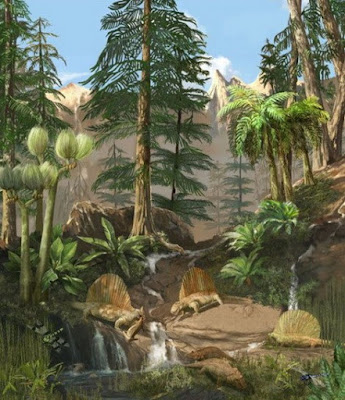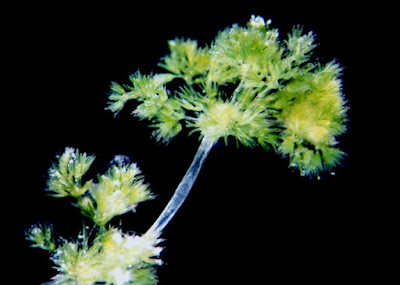From ground hugging to sky scraping. The rise of seedless vascular plants.
The evolution of seedless vascular plants towards the end of
the Silurian period, 425 million years ago, allowed for the re-transformation
of the pre-historic landscape. Originally desolate, then gradually filled with vertically
challenged, ground hugging bryophytes; The rise and prominence of seedless
vascular plants allowed for rigidity & vertical growth, which had previously
eluded the first permanent land dwelling flora (Evert, Raven & Eichhorn
2013).
As we’ve learnt from previous posts, both charophytes and
bryophytes lacked vascular tissue. This inevitably restricted their ability to
grow vertically, but also radiate in their new found terrestrial environment
without the constant availability of surface or ground water (Willis &
McElwain 2014). So, what enabled seedless vascular plants to rise above their
non-vascular counterparts, and successfully dominant the Silurian-Carboniferous landscape?
One of the most significant evolutionary innovations, along
with roots, stems and leaves, was the development of the xylem and phloem, the
vascular system. The xylem has an arrangement of elongated tube-shaped cells
which are called tracheids. These tracheids transport water and minerals from
the roots up to the rest of the plant. The water conducting cells are made up
of a synthesized polymer called lignin. Lignin not only provides structural
strength in the plant allowing for vertical growth, but also prevents the
collapsing of the transport cells when pulling water upwards against the forces
of gravity. The phloem is made up of living tissues which supply the rest of
the plant with glucose and other nutrients (Reece & Campbell 2012). http://www.dokimiscience.com/b---translocation.html
Seedless vascular plants are also able to branch profusely through
the activity of apical meristems. These are located on the tips of stems and branches
and allow for the increased transport of water and nutrients (Pearson 1995). Megaphylls, which are multi-veined leaves, increased the surface area of the plant and allowed for greater photosynthetic capacity. The
evolution of true root systems not only enhanced the ability to absorb water
and nutrients, but also anchored vascular plants allowing them to grow to new
heights (Reece & Campbell 2012).
The ability to grow tall also aided the domination of the
sporophyte (diploid) generation in the heteromorphic lifecycle of vascular plants. Decreasing
the size and life span of the water reliant gametophyte (haploid) stage, increased the
potential to diverge from permanent sources of water (Willis & McElwain
2014). Nutritionally independent and branched sporophytes also allowed for the evolution
of modified leaves known as sporophylls (Reece & Campbell 2012). These
produced multiple sporangia which release spores, and were able to be transported greater
distances, allowing for the geographic radiation & dominance of vascular
plants.
Now that we have a broad understanding about the vascular
system, my next post will explore the two phyla of seedless vascular plants, lycophyta and pterophyta.
References
Evert, R.F., Raven, P.H. & Eichhorn, S.E. 2013, Biology of plants, Eighth edn, W.H.
Freeman and Company Publishers, New York.
Pearson, L.C. 1995, The
diversity and evolution of plants, CRC Press, Boca Raton.
Reece, J.B. & Campbell, N.A. 2012, Campbell biology, 9th (Australian version) edn, Pearson Australia,
Frenchs Forest, N.S.W.
Willis, K.J. & McElwain, J.C. 2014, The evolution of plants, Second edn, Oxford University Press,
Oxford.
Bio I - K.Pl 2013, Ferns Pteridophyte life cycle. [Online video]



Welcome structure and stability! The vascular tissue was really quite innovative. Can you elaborate more on the molecular structure of lignin?
ReplyDelete